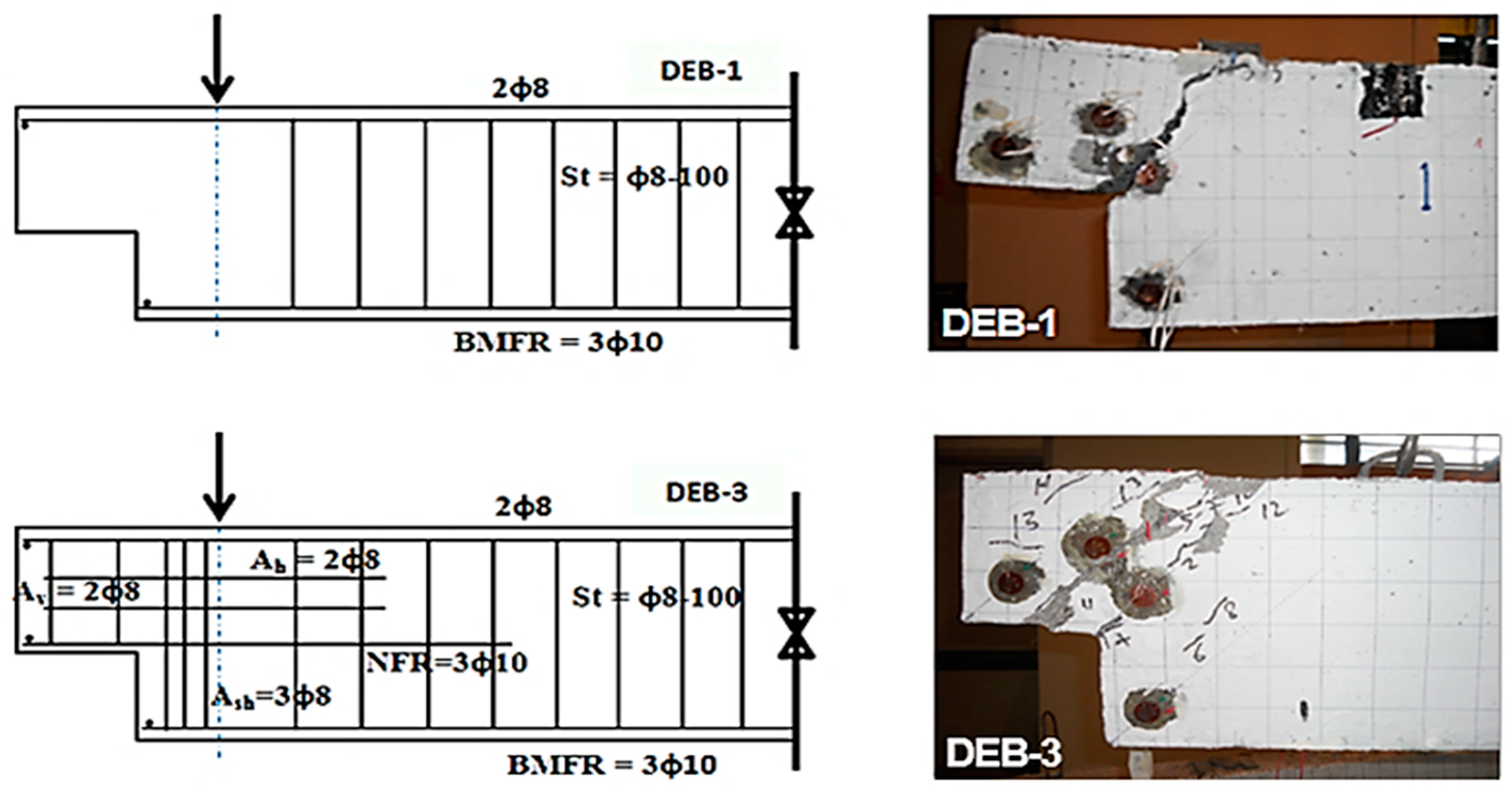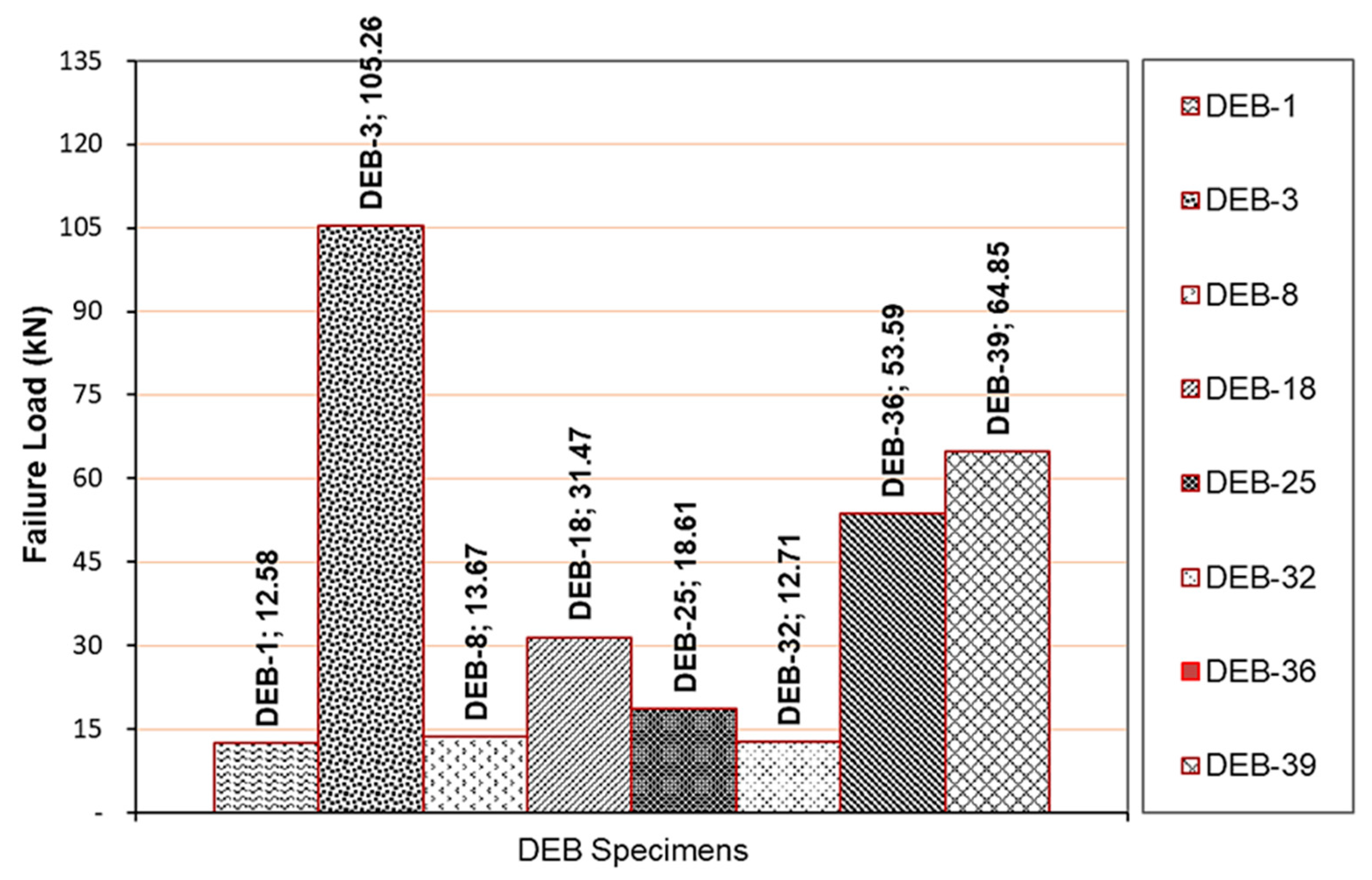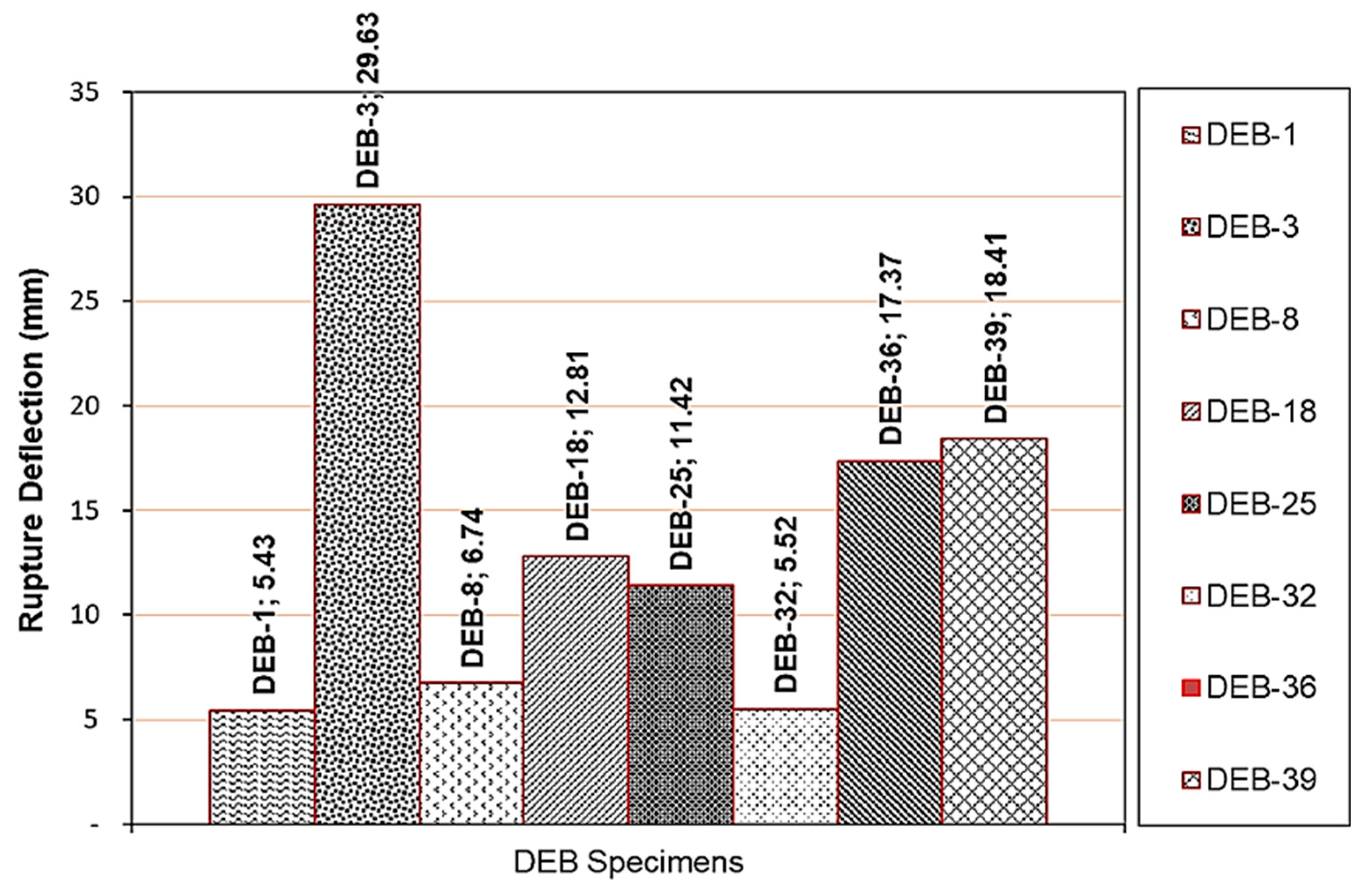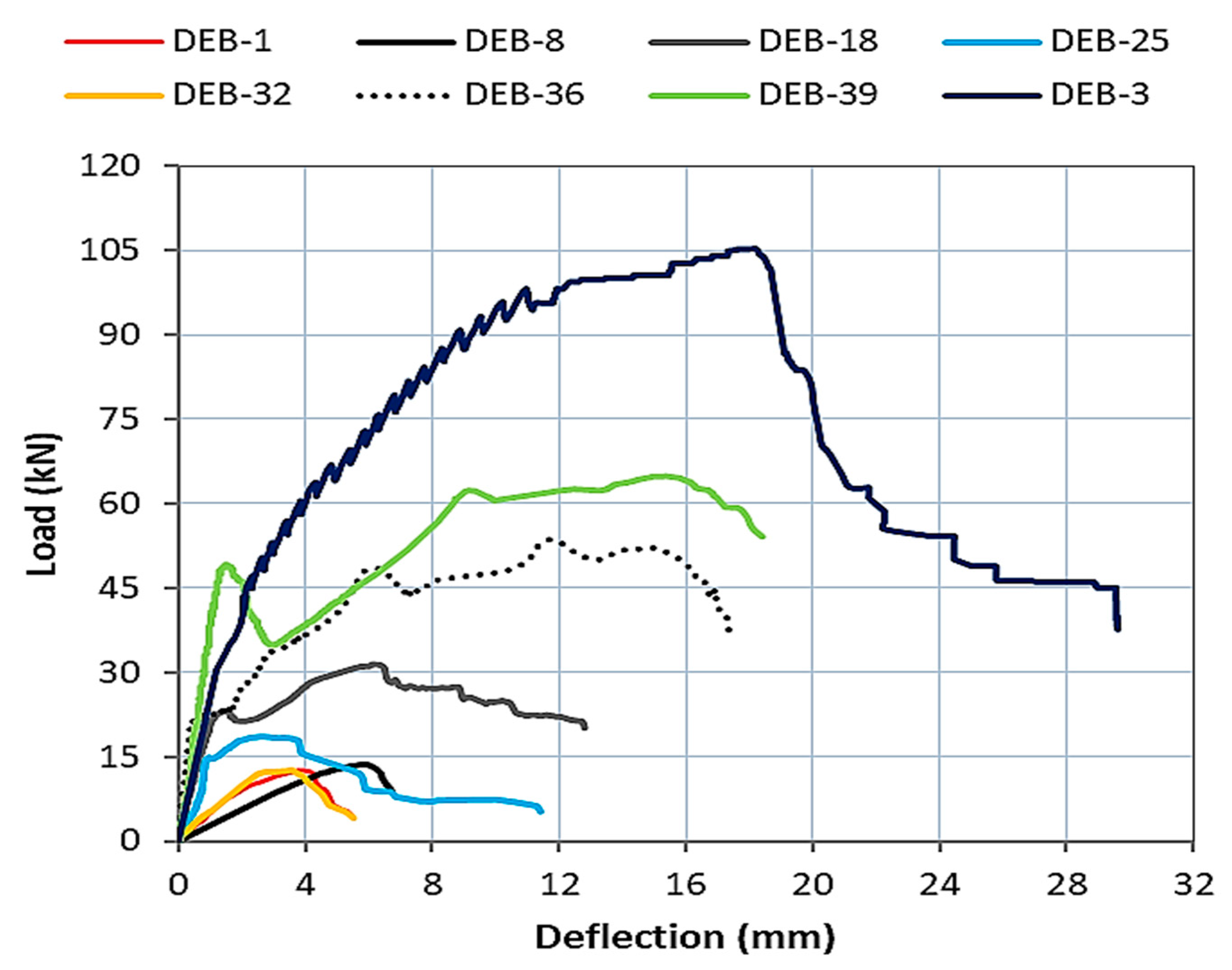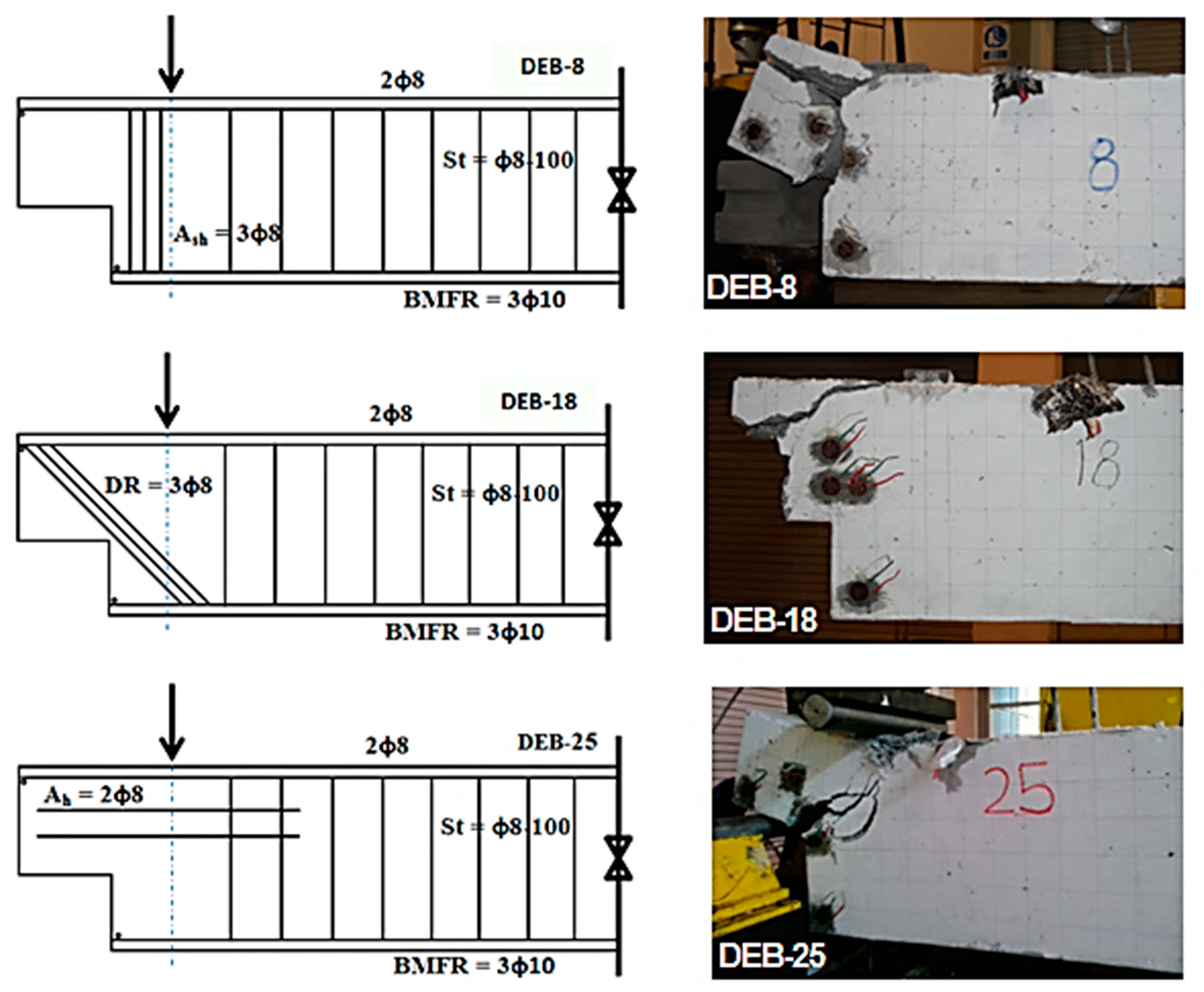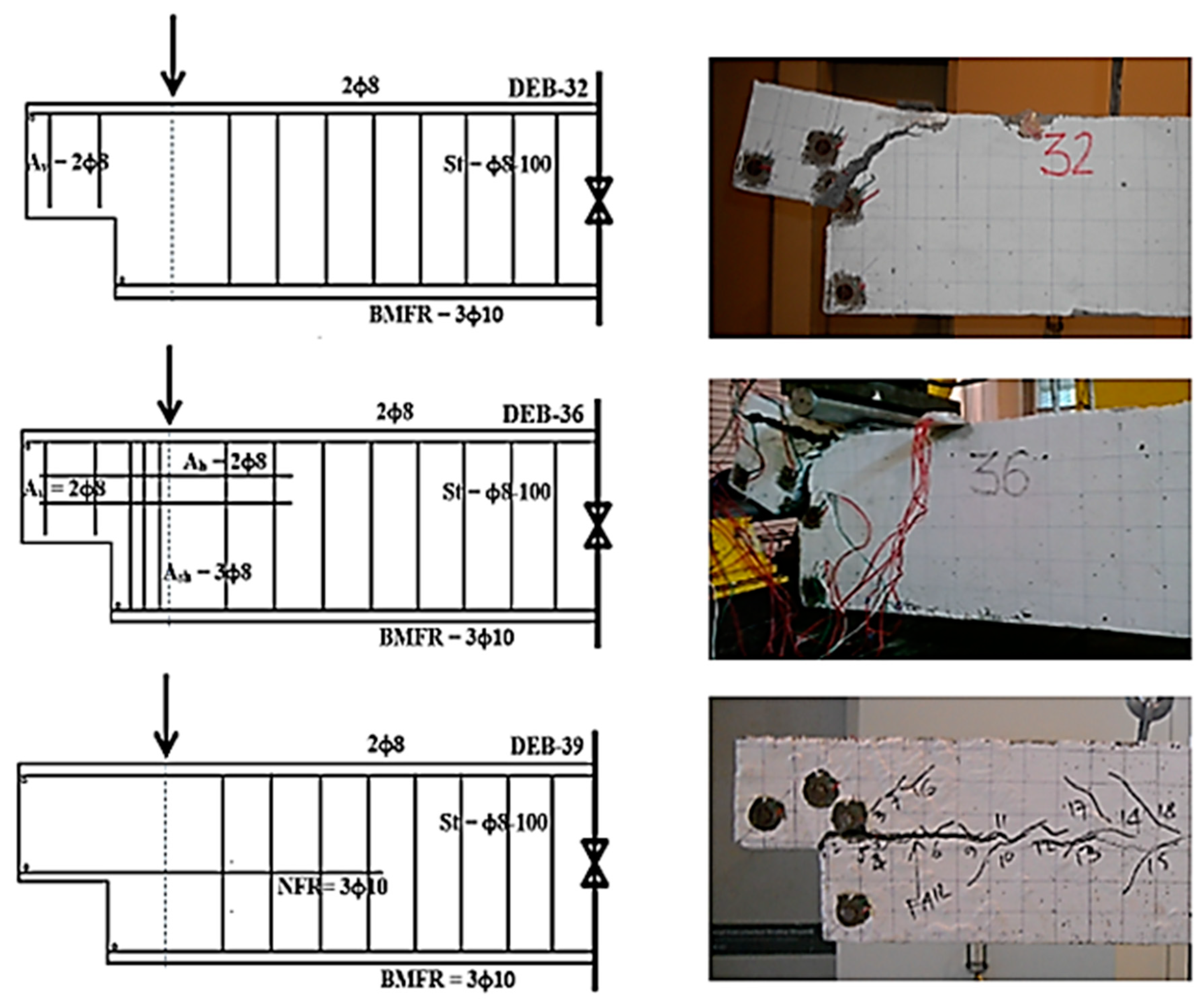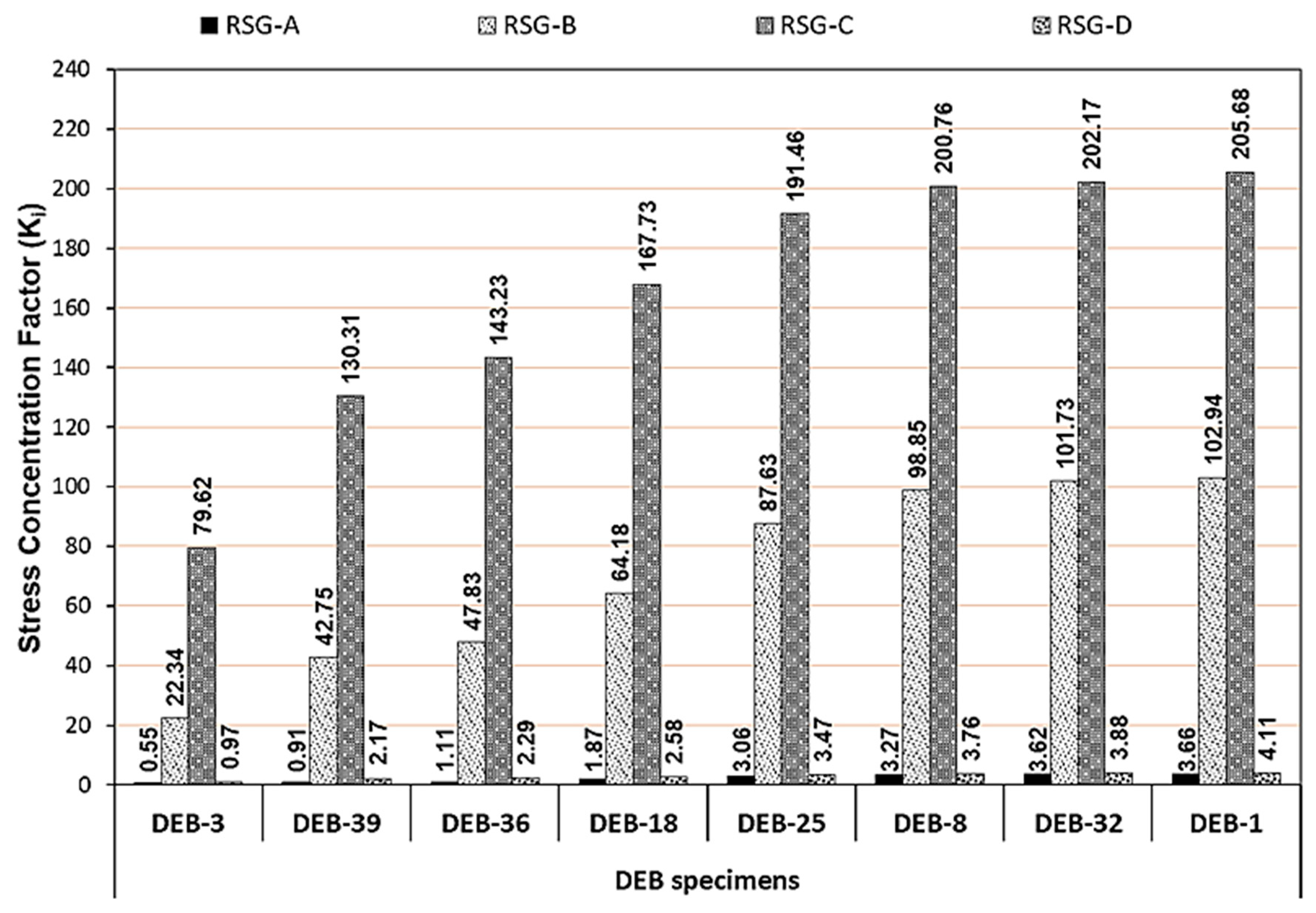3.2. The Role of Dapped-End Reinforcement on the Structural Behavior of RC-DEBs
DEB-3 is a control beam with the four groups of dapped-end reinforcement (i.e., NHRs, NVRs, HRs, and NFRS), whereas DEB-1 is a reference beam with no dapped-end reinforcement. The failure of DEB-3 was indicated by the occurrence of a few diagonal cracks at the dapped-end zone, whereas the failure of DEB-1 was defined by the occurrence of the major diagonal crack issuing from the re-entrant corner, as shown in
Figure 4,
Figure 5 and
Figure 6. This single crack propagates diagonally as the load increases without being prevented in its progression. The reference beam (DEB-1) has the lowest capacity when compared to other beams, with a failure load of 12.58 kN and a corresponding rupture deflection of 5.43 mm. Meanwhile, DEB-3 has the highest capacity among all DEBs, with a 736.72% increase in failure load and a 445.67% increase in the rupture deflection when compared to DEB-1. Failure load is meant as the maximum load. While rupture deflection is defined as the final deflection that occurs, which was recorded in the data logger, where the DEB specimen at that time has collapsed, the loading of the actuator machine has also stopped. The rupture deflection is intended to see how much ability of DEB specimens can withstand the working load when the DEB has actually reached its collapse.
Each group of steel reinforcements in the dapped-end area works to support each other to withstand the working load. Reduction of nib reinforcement in the dapped-end region can certainly cause a decrease in capacity. Desnerck et al. [
12] also provided a congruent statement that reduces the amount of steel reinforcement in the diagonal reinforcement. The nib vertical and nib horizontal reinforcement can lead to a reduction in the failure load capacity of 35% of the control specimen.
According to the load-deflection curves of all DEBs (as shown in
Figure 7), it can be seen that the specimen having the four groups of dapped-end reinforcement (i.e., DEB-3) exhibited the highest structural capacity with a failure load of 105.26 kN and a rupture deflection of 29.63 mm compared to other specimens. It can be seen that all groups reinforced with dapped-end reinforcement showed post-deflection after the ultimate failure load, which confirmed that the presence of steel reinforcement at the dapped-end region of the beams plays an important role in improving the structural performance of DEBs. Meanwhile, DEB-1 failed prematurely due to the absence of dapped-end reinforcement that would have prevented the cracks from propagating.
In DEB-8, the presence of HRs was quite effective in resisting the diagonal cracks coming from the re-entrant corner, but thereafter the cracks deviated and propagated vertically parallel to the direct shear plane until failure, as seen in
Figure 8. As there was no other steel reinforcement to resist these cracks, DEB-8 failed rapidly. However, as shown in
Figure 5,
Figure 6 and
Figure 7, the inclusion of only HRs in DEB-8 does not result in a considerable increase in load and deflection capacity, where the failure load and rupture deflection capacity are just marginally higher than that of DEB-1. In addition, HRs can also function to provide confinement strength in the un-dapped region, so that diagonal cracks emanating from the un-dapped part can be inhibited. This condition is in line with what has been revealed by Mattock and Chan [
13], who stated that in the case of dapped-end beams, the inclined compression force in the nib region has to be resisted by a tension force of a group of hanger reinforcement placed close to the full-depth end face of the beam. However, it should also be noted that the studies in this paper have proven that a group of hanger reinforcements cannot work alone. It will function effectively if it is supported by other nib reinforcements, such as NFRs, DRs, NHRs, etc. Meanwhile, according to Rajapakse et al. [
10], the addition of the amount of steel reinforcement in the hanger reinforcement group did not make a significant contribution, which only resulted in a 15% increase in strength.
DEB-18 was created by replacing the HRs group with the DRs group in DEB-8. Because of its location, a group of DRs is better equipped to resist diagonal cracks from the re-entrant corner than a group of HRs. Aside from that, a group of DRs can sustain the direct shear in the shear plane region and the flexural moments from the support reaction, where the support reaction dominates over the direct shear. As a result of this circumstance, a diagonal crack appears at the support and develops vertically until failure, as shown in
Figure 8. In comparison to DEB-8, DEB-18 has a 130.21% increase in failure load and a 90.06% increase in rupture deflection capacity, as shown in
Figure 5 and
Figure 6. According to the load-deflection curves shown in
Figure 7, it can be seen that DEB-18 has better behavior than DEB-8, which has a higher deformative deflection till rupture. It is concluded that the DRs group performed better than the HRs group.
This has been proven by Desnerck et al. [
11]: that the diagonal reinforcement plays a significant role in resisting the shear forces originating from the support. It was reported that dapped-end beams which having an inadequate diagonal reinforcement generated a 40% reduction in failure load capacity. Meanwhile, Aksoylu et al. [
5] reported that the use of diagonal reinforcement equipped with the proper anchorage model (called Type Z) in the dapped-end purlins resulted in approximately 30% higher load capacity than other specimens.
In the case of DEB-25, basically, the NHRs group was used as reinforcement with a secondary role. The first secondary role is to aid NVRs in resisting diagonal cracks from the nib section’s corner, and the second secondary role is to aid NFRs in resisting diagonal cracks from the support. Meanwhile, the third secondary function is to aid NFRs in resisting direct shear. As a result, if the confinement strength from NVRs and the existence of NFRs as the first layer are present, all tasks of the NHRs group may be efficiently performed. The failure mode of DEB-25 was characterized by a major diagonal crack originating from the re-entrant corner, as shown in
Figure 8. When the crack propagation reaches NHRs, however, the diagonal crack deviates slightly to the right. According to
Figure 5,
Figure 6 and
Figure 7, the behavior of DEB-25 is better than DEB-8, with a 36.14% increase in failure load and a 69.44% increase in rupture deflection capacity.
Furthermore, the use of the NVRs group for DEB-32 was intended to withstand a diagonal crack from the corner of the nib. However, the existence of the NVRs group does not operate properly due to the absence of NFRs as the anchorage holder for the NVRs’ legs. As a result, the load and deflection capacity, behavior, and failure modes of DEB-32 were identical to those of DEB-1, as seen in
Figure 5,
Figure 6,
Figure 7 and
Figure 9.
DEB-36 is a derivative of DEB-3 but without NFRs. It can be seen in
Figure 5,
Figure 6,
Figure 7 and
Figure 9 that the initial crack started at the re-entrant corner and moved diagonally. Because HRs exist, cracks propagation can be slowed, causing the cracks to propagate vertically until failure. On the other hand, because the NHRs group is less resistant to crack propagation than the HRs group, the crack pattern and failure modes are comparable to DEB-8. It turns out the DEB-36 has a higher failure load and rupture deflection capacity than the DEB-1, DEB-8, DEB-18, DEB-25, and DEB-32. This is due to the DEB-36’s incorporation of HRs, NVRs, and NHRs as part of its combined dapped-end reinforcement.
The NFRs group’s first and most important function is to resist the lateral stress and/or the diagonal stress from the support. The second function is to withstand the flexural moment induced by shear force at the support acting in accordance with the HRs group’s center point. In addition, another key function is to withstand direct shear at the dapped-end region’s interface or shear plane. NFRs also provide a supplementary role in preventing diagonal cracks in the dapped-end region. In terms of the primary and secondary roles of the NFRs group, the presence of NFRs has a significant impact on the structural performance of DEBs.
As illustrated in
Figure 9, the cracks from the re-entrant corner develop in the diagonal direction at first for DEB-39. However, because the NFRs group may prevent and resist these diagonal cracks, the cracks deviate horizontally and propagate to failure. As for the failure mode, it can be seen that de-bonding between NFRs and concrete along NFRs revealed the modes of failure. Moreover, DEB-39 has the maximum capacity (as shown in
Figure 5,
Figure 6 and
Figure 7) when compared to the other beams, which are DEB-1, DEB-8, DEB-18, DEB-25, DEB-32, and DEB-36. The failure load of DEB-39 was 64.85 kN, and the rupture deflection capacity was 18.41 mm. In addition, DEB-39 also has better behavior than other beams, where it showed a 106.07% increase in failure load and a 43.72% increase in rupture deflection when compared to DEB-18. Quadri and Fujiyama [
48] also proved the importance of bonding strength between the nib flexure reinforcement (NFR) and the concrete in the dapped-end area. As a result of static or dynamic loading, the bond deterioration that occurs at NFR will cause a decrease in the failure load capacity of 16.92–50% compared to the control RC-DEB.
This case demonstrated that the presence of the NFRs group has a significant influence on the structure performance of RC-DEBs. Furthermore, when compared to other groups of dapped-end reinforcement, such as HRs, DRs, NVHs, or NHRs, it performs the most vital role in impeding and resisting potential cracks that may develop within the dapped-end region. Finally, according to observations made during beam testing, the initial crack for all dapped-end beams was always begun from the re-entrant corner, and the shear failure is also classified as a failure mode for all DEBs. Actually, there have been quite a number of studies related to the dapped-end beams, which reported that due to dapped-end beams being subjected to the loads, initial cracks always appear from the re-entrant corner, as has been reported by many researchers, such as Mattock and Chan [
13], Desnerck et al. [
7], Rajapakse et al. [
10], Özkılıç et al. [
15], Berger [
49], and Shakir [
50].
3.3. The SCF Values of RC-DEBs
Based on the SCF analysis that refers to the RSGs data, it was found that the values of the normal and principal stresses were considerably different. As demonstrated in
Table 4,
Table 5,
Table 6 and
Table 7, the stresses have various values depending on the RSG position in the dapped-end region. It can be seen that the stress levels in the dapped-end region are not equally distributed, where some localized high stresses or stress concentrations occurred in this part.
As presented in
Table 4,
Table 5,
Table 6 and
Table 7 and shown in
Figure 10, the RSG-C data had the highest SCF values for each DEB specimen tested, then followed by RSG-B, RSG-D, and RSG-A. This means that the stress flows are more localized at the region which are close to the re-entrant corner and its vicinity. The stress values that occur at this region are very high, corresponding to stress concentration in the designated location. The SCF values decreased as the region moved away from the re-entrant corner, which is consistent with Saint Venant’s concept. Furthermore, the SCF values of the RSG-D were higher than those of the RSG-A. This demonstrates that the stress flows are more concentrated in the un-dapped region (where the RSG-D is located) than in the region adjacent to the nib corner (position of the RSG-A).
The fine cracks typically appeared in the un-dapped zone during the DEBs test. However, it did not occur in the region close to the nib corner. Furthermore, during the test, it was observed that the first crack always started at the re-entrant corner. Therefore, it can be seen that the re-entrant corner and its surroundings are constantly plagued with dominant cracks (including at the support). Thus, RC-DEBs’ damage and failure always begin here. The stress concentration that arises in the dapped-end area was due to the discontinuity of DEBs. FEM may be used to describe stress flows that arise in disturbed regions related to working loads, support reactions, openings, or other discontinuities, as reported by Aswin et al. [
41]. Meantime, Don et al. [
28] revealed that the predicted failure modes and the crack patterns of DEBs are consistently in accordance with those achieved experimentally, showing the localized ruptures at the re-entrant corner of the dapped-end region. In addition, Aksoylu et al. [
5] proved that according to the test results of all specimens, dominant shear failure and damage occurred at the thinned end part of dapped-end purlins. The existence of discontinuity in the dapped end region caused the stress path flows, resulting in the stress concentration at the re-entrant corners and its surrounding area, including the support region. Damage and failure always occur in the dapped-end region.
Further analysis revealed that there is a significant and interrelated relationship between the SCF value, the failure load capacity, and the scheme of the dapped-end reinforcement group based on the RSG-A, RSG-B, RSG-C, and RSG-D data of each RC-DEB. Each DEB with less dapped-end reinforcement and an insufficient main role of the dapped-end reinforcement group had a low failure load capacity and a high SCF value. Nevertheless, DEB with more and or full dapped-end reinforcement, as well as a sufficient main role of the dapped-end reinforcement group, always generates a high failure load capacity and a low SCF value. DEB-1 had the smallest failure load capacity (12.58 kN) yet the highest SCF value (205.68). Discontinuity and stress flow in DEB-1’s dapped-end region create localized extremely high stress. Because of this situation, as well as the lack of dapped-end reinforcement, diagonal cracks develop and move fast up to failure, resulting in the least failure load capacity. In contrast, DEB-1, DEB-18, DEB-25, DEB-36, DEB-39, and DEB-3 had a more complete dapped-end reinforcement and a sufficient group of dapped-end reinforcement. DEB-3, on the other hand, has the largest failure load capacity (105.26 kN) and the lowest SCF value (79.62). The stress flows that occur in the dapped-end region can be inhibited and resisted by employing the dapped-end reinforcement groups, which are then uniformly distributed in the surrounding areas. Finally, the localized high stress can be minimized, yielding the lowest SCF value. Mohammed, Ean and Malek [
43] revealed that due to the applied load, the upper corners of the opening of RC walls experienced high principal stresses along with a lower failure load capacity. Nevertheless, once the openings strengthened using CFRP, it turns out the load-carrying capacity improved. Meanwhile, the stress concentration factor decreases. It is worth noting that the CFRP pattern with 45⁰ to the corners provides better results. The CFRP strengthening is able to resist the working load and disseminate the high-stress flows sufficiently, resulting in lower SCF values.
In comparison to DEB-1, DEB-8, DEB-18, DEB-25, DEB-32, and DEB-36, the DEB-39 (which only uses the NFRs group) provided the highest structural performance and played the most important role in resisting the potential and progressive cracks that occur within the dapped-end region. This can be led to the conclusion that the use of the NFRs group is superior compared to other groups of the dapped-end reinforcement, such as HRs, DRs, NVRs, or NHRs.



